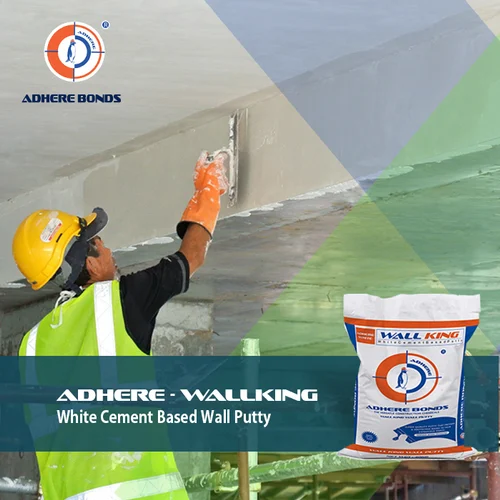WallPutty: The Secret to Smooth and Durable Finishes

Wall putty is a type of finishing material used to smooth and prepare surfaces, particularly walls, for painting and other decorative applications. It provides a smooth, even base for applying paint or wallpaper, ensuring a flawless and durable finish. Wall putty is commonly used in residential, commercial, and industrial settings, offering a range of benefits that improve the aesthetic quality and longevity of walls.
Adhere Wall King (white cement-based wall putty) effectively fills the fine pores of concrete, mortar walls, and ceilings (both interior and exterior), creating a smooth, dry surface ideal for painting. It offers superior water resistance, enhanced durability, strong adhesive strength, and helps extend the life of your paint. Adhere Wall King can even be applied to slightly moist surfaces.
What is WallPutty?
Wall putty is typically made from a mixture of white cement, minerals, and other additives that improve its bonding properties. It is applied to walls in a thin layer to fill in cracks, holes, and other imperfections, creating a smooth surface. There are two main types of wall putty:
- Cement-based Wall Putty: Made from white cement, it provides strong adhesion and durability.
- Polymer-based Wall Putty: A more advanced formulation that offers additional flexibility and is often used for specific applications like high-moisture areas.
Choosing the Right WallPutty
When selecting a wall putty, consider the following factors:
- Surface Condition: Choose a heavy-duty putty for repairing large cracks or damaged walls and a lighter version for smoothing walls before painting.
- Moisture Levels: For high-moisture areas, look for wall putty with moisture-resistant properties to avoid mold and mildew growth.
- Application Area: Interior wall putty is different from exterior wall putty, so make sure to choose one suited to the specific environment.
People Asked Question
what are the benefits of wall putty?
Smooth Surface for Painting: Wall putty ensures a smooth, even surface for the application of paint, preventing the paint from absorbing unevenly into the wall and resulting in a flawless finish.
Crack and Imperfection Filling: Wall putty helps fill minor cracks, dents, and holes in walls, making them appear new and well-maintained.
Improved Adhesion: The putty provides an excellent bonding surface for the paint, allowing for better adhesion and a longer-lasting finish.
Moisture Resistance: Some types of wall putty are designed to resist moisture, helping to prevent mold and mildew growth on walls in humid environments like bathrooms and kitchens.
Enhanced Durability: By providing a smooth and solid surface, wall putty increases the durability of the paint, extending the life of the finish and reducing the need for frequent touch-ups.
How to Apply Wall Putty?
Applying wall putty is a simple yet essential step in achieving a high-quality finish. Here’s a step-by-step guide:
Surface Preparation: Begin by cleaning the wall surface. Remove dirt, dust, and grease. If necessary, use a mild detergent or water to wash the surface and let it dry completely.
Mixing the Putty: If you’re using powder-based wall putty, mix it with water according to the manufacturer’s instructions until it forms a smooth paste.
Application: Using a putty knife or a trowel, apply a thin, even layer of putty over the wall, starting from the corners and edges. Smooth it out, covering any cracks or holes.
Drying: Allow the putty to dry completely. Drying time may vary depending on the thickness of the application and environmental conditions.
Sanding: Once dry, lightly sand the surface using fine-grit sandpaper to ensure it is perfectly smooth and even.
Second Coat (if needed): If the wall has significant imperfections, apply a second coat of putty, following the same process, and allow it to dry and sand again.
Ready for Painting: Once the putty is dry and smooth, your wall is ready for painting or other decorative treatments.
What are the types of Wall Putty Available
Interior Wall Putty: Designed for use in dry, indoor areas such as living rooms, bedrooms, and offices. It provides smoothness and ensures better paint adhesion.
Exterior Wall Putty: Specifically formulated for outdoor walls, it offers enhanced resistance to weather conditions like rain, heat, and humidity, making it suitable for outdoor facades.
Water-based Wall Putty: A popular choice for its ease of application and eco-friendly properties, water-based putties are ideal for interior walls.
Oil-based Wall Putty: Often used in industrial applications, oil-based putties provide excellent resistance to moisture and are more durable but take longer to dry.
